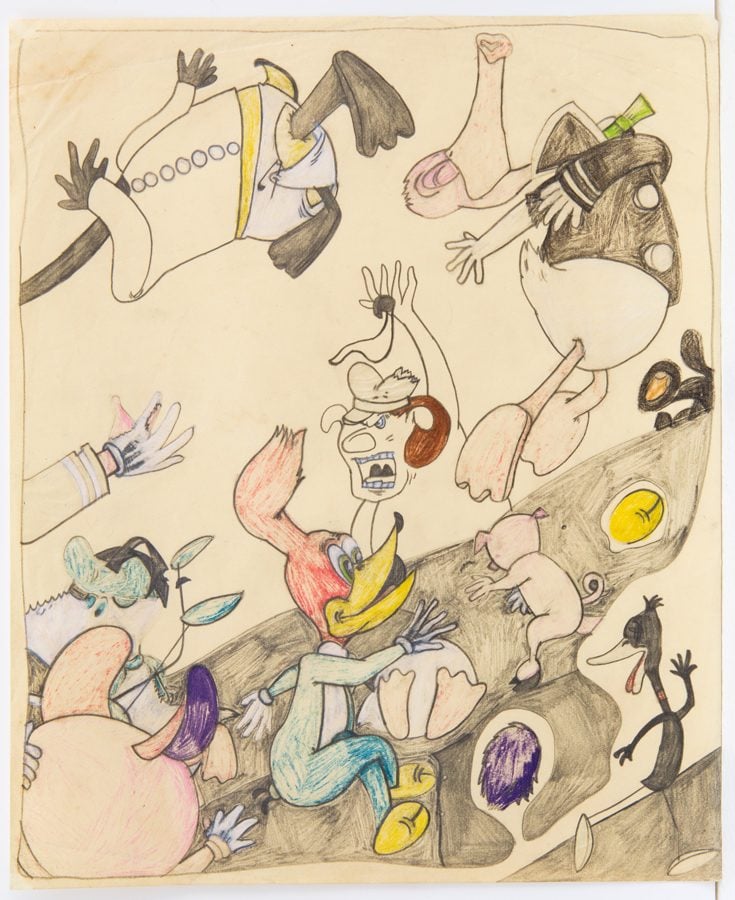Intuit showcases non-verbal artist’s life’s work
Source: Chris Byrne and the Andrew Edlin Gallery
Susan Te Kahurangi King’s early artwork depicts surreal landscapes and abstract cartoon imageries. Her work will be on display at Intuit Thursday through Aug. 4.
March 6, 2019
A&E
On a scrap of paper, a cluster of humans and humanoids wiggle and wave in chaos. Their open mouths are frozen mid-shout, but their creator, Susan Te Kahurangi King, hasn’t spoken a word in over 50 years.
The New Zealand-based artist’s work will be on display at The Center For Intuitive And Outsider Art (Intuit) in a new exhibition, “Susan Te Kahurangi King: 1958-2018,” Thursday through Aug. 4. The exhibition showcases more than 60 of her drawings, along with memorabilia that has never been displayed before.
King, who is on the autism spectrum, stopped speaking around the age of four, her younger sister Petita Cole said. Since then, vivid images created with pens and charcoals have been King’s primary means of expression. Her family was perplexed with her silence, Cole said, and in an attempt to understand her better, they collected every piece of artwork she produced in childhood.
Cole said her family has always appreciated King’s drawings. When the family introduced King to others when they were kids, Cole said they would say, “This is Susan. She doesn’t talk, but she does great art.”
The family sent King to a school for children with learning disabilities, where her self-expression was inhibited, Cole said. She said at the school, King’s teacher lectured her that making art was not appropriate for grown-ups, which made King quit drawing.
In 2005, Cole said she decided to promote King’s drawings through digitizing and cataloging her previous works. As King finally gained worldwide attention and recognition, she started drawing again with renewed vigor.
The Intuit exhibition includes King’s recent work of gouache brush and mosaics, along with many childhood drawings. Her early work includes some colorful mashups that depict surreal landscapes and abstract cartoon imageries, such as distorted Donald Duck, Fanta’s clown and the Teenage Mutant Ninja Turtles, curator Alison Amick said.
“There are some deconstructed popular culture elements in her art that remind people of things they might have enjoyed in their years of growing up,” Amick said. “At the same time, there is also something concerning and dark about those cartoonish smiles.”
Over the past decade, Cole said she has been uncovering the context of King’s art by going through written and photographic materials from her childhood. Cole said one of the inspirations for King’s early drawings might come from the time King spent in the psychiatric ward of a hospital in Auckland as a teen. Cole said her parents believed that King had experienced brutal treatment under the hospital’s care, leaving her with disturbing memories that turned into faces in her drawings.
Aside from King’s unique personal vision, Cole added that King is different from other artists because she never had an audience in mind. Sometimes King drew with a white pencil on white paper or black on black, Cole said, and she would continue to draw with a pen even after the ink had run out.
“It is almost like transcribing something (in her brain),” Cole said. “She doesn’t look forward to a response. She just wants to get it out there.”
Debra Kerr, the executive director at Intuit, said she has witnessed a similar motivation that drives other outsider artists to create beauty from simple materials.
“(Outsider artists) have a compulsion to create, and they often do that with whatever is at hand,” Kerr said.
Kerr added that she thinks King’s success will inspire other people who have a combination of special abilities and disabilities.
“This is art made by people who are self-taught and in many cases have had some barrier to overcome disenfranchisement,” Kerr said. “I think it’s exciting to celebrate the work of an artist who in another time might have been overlooked or dismissed.”
Email: Xuandiwang2022@u.northwestern.edu
Twitter: @aaronwangxxx
Related Stories:
— Dittmar Gallery holds exhibition showcasing systemic violence through sculpture
— NU alumnus explores the “twilight zone” of identities in upcoming photo exhibition



